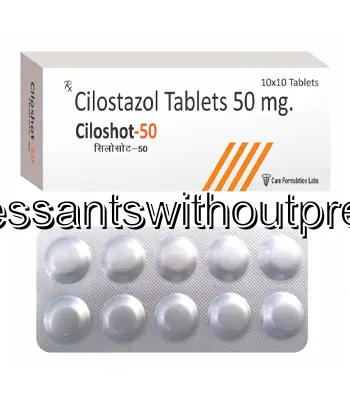| Package | Dosage | Price | Price per Dose | |
|---|---|---|---|---|
| Dosage: 50mg | ||||
| 360 pill | 50mg | $488.05 | $1.36 | |
| 180 pill | 50mg | $261.56 | $1.45 | |
| 120 pill | 50mg | $197.76 | $1.64 | |
| 90 pill | 50mg | $167.46 | $1.87 | |
| 60 pill | 50mg | $124.39 | $2.07 | |
| 30 pill | 50mg | $65.38 | $2.19 | |
| Dosage: 100mg | ||||
| 360 pill | 100mg | $850.12 | $2.36 | |
| 180 pill | 100mg | $430.63 | $2.39 | |
| 120 pill | 100mg | $293.46 | $2.44 | |
| 90 pill | 100mg | $226.47 | $2.52 | |
| 60 pill | 100mg | $154.70 | $2.58 | |
| 30 pill | 100mg | $87.71 | $2.92 | |

Cilostazol Description
Introduction to Cilostazol
Cilostazol is a medication frequently prescribed to improve symptoms related to peripheral artery disease (PAD). It belongs to a class of drugs known as phosphodiesterase III inhibitors. By increasing cyclic adenosine monophosphate (cAMP) levels within cells, Cilostazol helps relax blood vessels, leading to increased blood flow. This action can relieve claudication symptoms, which are characterized by leg pain during activity. Patients with PAD often find Cilostazol beneficial as it can enhance their walking distance and overall quality of life.
Mechanism of Action
The primary mechanism of Cilostazol involves the inhibition of phosphodiesterase III enzyme. This results in elevated cAMP levels in platelets and vascular smooth muscle cells. The increased cAMP causes vasodilation, or widening of blood vessels, facilitating better circulation. Additionally, Cilostazol has antiplatelet effects that reduce blood clot formation, thereby decreasing the risk of further arterial blockages. The combined actions help improve blood supply to affected limbs, alleviating ischemic symptoms associated with PAD.
Benefits and Effectiveness
Mentioned as effective in clinical settings, Cilostazol can significantly reduce symptoms like leg pain and cramping during physical activity. Many patients report an increase in walking distance and a greater ability to perform daily tasks. Studies suggest that Cilostazol has a favorable safety profile when used appropriately. Its quick onset of action and tolerability make it a popular choice for managing PAD symptoms. However, maximum benefits are usually observed after several weeks of consistent use.
Potential Side Effects
Like all medications, Cilostazol can cause side effects. Common issues include headaches, dizziness, diarrhea, and palpitations. Some patients might experience abdominal discomfort or nausea. Serious adverse reactions are rare but can include chest pain or signs of bleeding due to its antiplatelet properties. It is important for patients to report any unusual symptoms to their healthcare provider. Regular monitoring can help minimize potential risks associated with therapy.
Precautions and Contraindications
Cilostazol should be used with caution in patients with heart failure due to its cardiovascular effects. It is contraindicated in patients with active bleeding or bleeding disorders because of its blood-thinning properties. Pregnant or breastfeeding women should consult their healthcare provider before starting treatment. Additionally, patients taking other anticoagulants or antiplatelet drugs need to be closely monitored to prevent excessive bleeding. Proper evaluation and medical supervision are essential for safe and effective use.
Usage and Dosage
The typical prescribed dose of Cilostazol is 100 mg twice daily. It is recommended to take the medication approximately 30 minutes before or two hours after a meal for optimal absorption. Patients should adhere strictly to their doctor's instructions regarding dosage and duration of therapy. Consistent use is vital to achieving the desired improvements in symptoms. Any adjustments should only be made under medical supervision.
Conclusion
Cilostazol remains a valuable option for managing symptoms of peripheral artery disease. Its ability to improve blood flow and reduce pain makes it a helpful tool for many individuals. Despite its benefits, careful consideration of potential side effects and contraindications is necessary. Patients should work closely with their healthcare providers to ensure safe and effective treatment. Regular follow-up can help optimize outcomes and address any concerns during therapy with Cilostazol.
